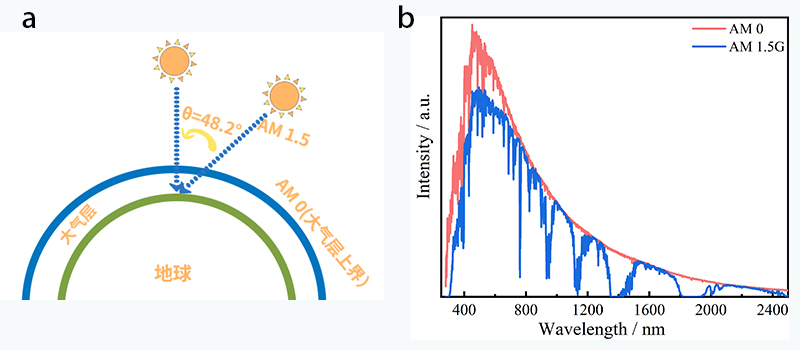The irradiance on the surface of the sun (radiation energy per unit area) is 63.2 MW/m2. As sunlight travels through space and Earth's atmosphere to reach the Earth's surface, its irradiance continuously decreases.
To quantify the attenuation of solar radiation, people commonly use "air mass" (AM) as a marker. Air mass refers to the extent to which the atmosphere affects the reception of sunlight on the Earth's surface[1].
1. AM 0
The state of zero air mass (AM 0) refers to the reception of sunlight in outer space. When sunlight travels approximately 150 million kilometers through space to reach the upper boundary of the Earth's atmosphere, as shown in Figure 1, its irradiance decreases to 1353 W/m2. This value is considered a constant and is known as the solar constant, representing the standard irradiance at zero air mass, denoted as AM 0.

Figure 1. Illustration of AM 0, AM 1.5, and AM 1.5G and Spectra of AM 0 and AM 1.5G
2. AM 1.5
As sunlight enters the Earth's atmosphere, its radiant energy attenuates by over 30%. Due to variations in the angle at which sunlight enters and the thickness of the atmosphere it passes through, the degree of solar radiation attenuation varies.
If we set the zenith angle (the angle between the incoming sunlight and the surface normal) at which sunlight enters the Earth as θ, then the relationship between air mass and θ can be expressed as: AM=1/cosθ.
When θ = 48.2°, the air mass is AM 1.5. As shown in Figure 1, this represents typical sunny conditions when sunlight reaches the general surface of the Earth, closer to real-life situations, with an irradiance of 1000 W/m2.
AM 1.5 is commonly used as the standard for assessing the incident energy on terrestrial solar conversion devices and components.
3. AM 1.5G
AM 1.5G refers to the standard spectrum at the Earth's surface, with 'G' standing for Global.
AM 1.5G is derived from an ASTM (American Society of Testing Materials) standard related to solar energy[2]. To facilitate the comparison of solar conversion efficiency measurements taken at different times and locations, AM 1.5G is defined as the reference spectrum for standard testing of solar energy conversion systems, with a specified standard irradiance of 1000 W/m2.
4. Comparison of AM 0 and AM 1.5G Spectra
Prior to passing through the Earth's atmosphere, over 99% of solar radiation energy is distributed in the range of 150 to 4000 nm. About 50% of solar radiation energy falls within the visible spectrum, i.e., wavelengths from 400 to 780 nm. 7% is in the ultraviolet spectrum (wavelengths <400 nm), and 43% is in the infrared spectrum (wavelengths >780 nm). The maximum energy occurs at approximately 500 nm, in the blue-green light band. Refer to the spectrum of AM 0 in Figure 1 for details.
After sunlight passes through the Earth's atmosphere to reach the surface, both its irradiance and spectral distribution change. Refer to the spectrum of AM 1.5G in Figure 1 for details. Oxygen, ozone, and nitrogen in the atmosphere absorb light with a wavelength of 300 nm. Water vapor absorbs light at wavelengths of 900 nm, 1100 nm, 1400 nm, and 1900 nm. CO₂ absorbs light at wavelengths of 1800 nm and 2600 nm.
In photochemical experiments, to obtain the standard solar spectrum of AM 1.5G, a xenon lamp source is often used in combination with an AM 1.5G filter as a simulated light source for solar light.